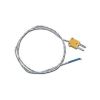Extech 5-in-1 Environmental Meter
Features
- Type K input measures temperature up to 2372° (1300°C)
- Built-in low friction vane wheel
- Utilizes precision photo diode and correction filter
- Free ground shipping
- Expedited repair and warranty service
- Lifetime technical support
- More
Overview
The Extech Hygro-Thermo-Anemometer-Light-Sound Meter is a rugged 5-in-1 environmental meter that measures humidity, temperature, air velocity, light, and sound. The characters on display can reverse direction depending on the meter mode. The built-in low friction vane wheel improves the accuracy of air velocity, the precision thin-film capacitance humidity sensor for fast response, and the thermistor for ambient temperature measurements.
Mechanics
The type K input measures temperature up to 2372°F. The meter utilizes a precision photo diode and correction filter for cosine and color-corrected light measurements. the sound level measurement meets IEC 61672 class 2 using A frequency weighting and fast response time. An optional tripod mount allows for continuous measurements.
- Air velocity
- ft/min range: 80 to 5910 ft/min
- ft/min resolution: 1ft/min
- ft/min basic accuracy: ±3% FS
- m/s range: 0.4 to 30m/s
- m/s resolution: 0.1m/s
- m/s basic accuracy: ±3% FS
- km/h range: 1.4 to 108km/h
- km/h resolution: .01km/h
- km/h basic accuracy: ±3% FS
- MPH range: 0.9 to 67MPH
- MPH resolution: 0.1PMH
- MPH basic accuracy: ±3% FS
- Light
- Foot candles range: 0 to 1860Fc
- Foot candles resolution: 0.1Fc
- Foot candles basic accuracy: ±(5% rdg + 8d)
- Lux range: 0 to 20,000Lux
- Lux resolution: 1Lux
- Lux basic accuracy: ±(5% rdg + 8d)
- Relative humidity
- RH range: 10 to 95%RH
- RH resolution: 0.1%RH
- RH basic accuracy: ±4%RH of rdg
- Temperature
- Thermistor range: 32 to 122°F (0 to 50°C)
- Thermistor resolution: 0.1°
- Thermistor basic accuracy: ±2.5°F/ 1.2°C
- Type k range: -148 to 2372°F (-100 to 1300°C)
- Type k resolution: 0.1
- Type k basic accuracy: ±(1%+2°F1°C) of rdg
- Sound
- dB range: 35 to 150dB
- dB resolution: 0.1dB
- dB basic accuracy: ±1.4dB
- Frequency range: 31.5 to 8,000Hz
- General
- Weighting/response: A weighting/fast response
- Power: 6 X AAA batteries
- Dimensions: meter, 9.8 x 2.8 x 1.3" (248 x 70 x 34mm); vane, 1.2" (31mm)
- Weight: 11.8oz (335g)
- (1) Meter
- (1) Type k thermocouple probe
- (1) Vane wheel
- (1) Windscreen
- (1) Pouch case
- (6) 1.5V AAA batteries
In The News
Wildfire Prevention in the Sierra Nevada Region with the Yuba Watershed Institute
Though recent wildfires have sparked new conversations about wildfire management and response, groups like the Yuba Watershed Institute have been monitoring the forests and water resources of the Sierra Nevada region for decades, managing approximately 5,000 acres of land with the Bureau of Land Management (BLM) and about 7,000 acres in private land partnerships. The goal of the Institute is to work with local communities and land agencies to improve watershed and forestry management through informed practices and public outreach. The goals of the Yuba Watershed Institute are three-fold: Improve the ability of fire suppression agencies like the California Department of Forestry and Fire Protection ( CAL FIRE ) and the US Forest Service.
Read MoreWave Sensors Integration with NexSens Buoys: A Cutting-Edge Solution for Wave Measurment
Real-time wave data supports accurate weather prediction, safe and efficient maritime operations, and provides valuable safety and operating condition information for recreation and commercial fishing. Understanding wave dynamics also helps with the design of protective coastal structures like seawalls, breakwaters, and jetties. It also supports better prediction of their impact on sediment transport and coastal geomorphology. Wave data is a key factor in qualifying and designing offshore wind farms and harnessing kinetic energy for electrical generation. It helps with the understanding of ocean-atmosphere interactions and contributes to studies of sea-level rise and climate change impacts.
Read MoreSpring 2025 Environmental Monitor Available Now
In the Spring 2025 edition of the Environmental Monitor, we highlight partnerships across the world and the importance of collaboration between government agencies, universities, environmental groups, local communities, and other stakeholders. From great white shark research in Cape Cod to monitoring fisheries in Lake Erie, this latest edition underscores partnerships that connect stakeholders in a watershed through environmental data. With an emphasis on data sharing, a combination of real-time and discrete sampling keeps the public and partners informed of environmental conditions. Our writers also sought out science professionals dedicated to working with peers within and outside of the environmental sector.
Read More








